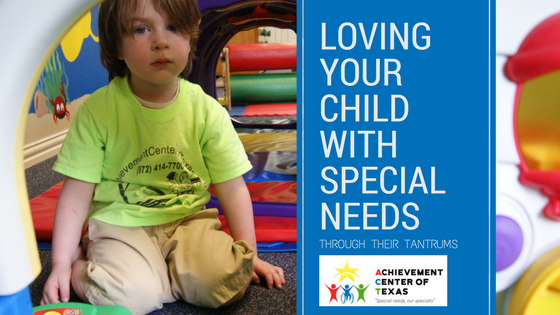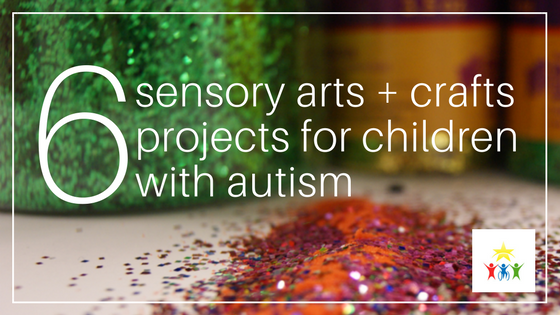Loving Your Child with Special Needs through Their Tantrums
 (Made in Canva)
(Made in Canva)
Individuals with special needs can sometimes be susceptible to behavioral outbursts. Facing a string of tantrums can grow tedious for parents of special needs children like you. Regardless of the tantrum’s cause, it’s important to keep a cool head and learn how to calm your child down under difficult circumstances.
Understand and validate your child’s feelings in order to better comprehend the trigger to their meltdowns and discover ways to soothe them. It’s also important to know the difference between a tantrum and a sensory meltdown, as the two require different preventive strategies and solutions. Differences between a tantrum and sensory meltdown include:
- tantrums reflect bad behavior while sensory meltdowns are neurological
- tantrums are thrown for attention
- tantrums stop when you give in
- sensory meltdowns might hurt your child
- You can learn more about the difference between the two here.
When it comes to behavioral outbursts with special needs kids, every child behaves differently. However, these are some common triggers that lead to meltdowns, ways to prevent meltdowns and what to do in case a meltdown does occur.
CAUSES OF TANTRUMS IN SPECIAL NEEDS CHILDREN
Ineffective communication
Depending on ability level, children with disabilities can have difficulty communicating their wants and needs. They try to express their emotions but children get frustrated and may throw tantrums when they’re not understood.
Your child’s ability to communicate may also affect the frequency and extremity of their tantrums. The more frustrated your child gets, the more frequent and intense the tantrums could become. In these situations, it’s important to remain calm and do your best to help manage your child’s emotions.
Patience is key.
Over (and under) stimulation
Children with special needs often find it difficult to cope with crowds and interact with strangers. Interacting with other children, partaking in therapy sessions and too much playtime can be exhausting and uncomfortable.
Too much stimulation can potentially lead to a meltdown. At the same time, if your child is under-stimulated or not mentally or physically occupied, this could also trigger an outburst.
New environments
Generally, people are more comfortable in environments they are familiar with. Likewise, new environments can put your special needs child on edge and on guard.
Meeting new people triggers this uneasiness. Activities like visiting a stranger’s house can lead to frustrations that trigger outbursts.
Interference
Children tend to run on their own agendas, marching to the beat of their own drums. Being asked to perform different activities like getting dressed or going to bed can throw off that beat. This leads to frustration, which triggers meltdowns. The same frustrations arise when kids are stopped from doing certain activities, like playing with their toys or coloring.
Car rides
Car rides can be long and boring, especially for children with special needs and with short attention spans. If your child isn’t mentally or physically stimulated during these rides, they can grow uncomfortable, making them more susceptible to meltdowns.
Meltdowns can worsen if a child is traveling on public transportation as crowds, waiting periods and longer travel times can decrease comfort substantially.
PREVENTION OF TANTRUMS IN SPECIAL NEEDS CHILDREN
Maintain a visual planner
Visual planners show children how their day is going to look and what tasks they’ll need to complete. Planners are helpful in giving your child a head’s up on how much time they have left for completing certain activities. They tell them when they have to move on to the next task.
Planners also mentally prepare your child to leave or end their activities beforehand. This helps prepare children for their day, decreasing the chances of a meltdown in the long run while setting a routine for your child to follow.
However, it’s helpful to alternate between non-preferred and preferred activities so your child has something to look forward to after each activity. Try to make sure to leave plenty of time for difficult transitions as well.
Keep your child distracted
When your child begins to show signs for a potential tantrum, your first reaction should be to distract them. Distraction can be achieved by blowing bubbles, telling a story, singing a song or playing a game to keep the child’s mind off of whatever trigger may be distressing them at the moment.
This strategy can prove especially helpful during waiting periods as well, such as when you and your child are waiting at the doctor’s clinic or for your bus to arrive.
Give your child options
By giving your child options, you help stimulate a form of control over their life and encourage them to ask for what they want. Options also help you learn more about your child’s wants and needs, preparing you to know what your child’s needs may be in the future.
Have a comfort object
Children usually have an object that soothes them, a particular object that stands out from the rest. It might be helpful to allow your child to bring a comfort object with them while going to therapy sessions, doctor appointments or when they are out running errands with you.
Have an end of activity signal
Besides giving your child constant reminders of how much time they have left before they have to move on to a different activity, you can also perform the same actions every time an activity ends.
For example, you could sing the “Cleanup Song” with your child before cleaning up or turn off the lights when it is time to go. You can also assign your child a certain job, like pulling the curtains, to help make the transition easier.
Take a sensory break
Sometimes kids have a lot of energy just bottled up inside them or they may grow frustrated from doing a single activity for a long period of time. To avoid frustration and meltdowns, you can leave some jump ropes or a mini trampoline in the corner of a room. This way, your kid can take a break from time to time and release some of that bottled up energy.
Encourage good behaviors
Appreciation goes a long way, especially with children with special needs. If your child is acting out, it can help to ignore bad behaviors while being sure to always appreciate good ones. This way, your child will be encouraged to continue to act in a way that ensures they’ll receive attention and appreciation.
Start when your child is young
From an early age, you can start teaching your child simple self-soothing techniques, such as:
- Deep breathing
- Stretching
- Listening to soothing music
- Imagining pleasant places or activities
These techniques can help them later on, especially if you’re not around when the tantrum occurs. It also helps to teach your child “feeling vocabulary” so they can learn to better express themselves. They’ll also learn how to express their emotions constructively by pursuing different activities, like painting.
Keep yourself organized
It’s important to remain calm and level-headed in case your child experiences a meltdown. Keep different techniques and ideas in mind to prepare yourself for different situations. Remember to relax, it will take time before you realize what works best for your child and once you do, remember to always be consistent.
ACTIONS TO STOP TANTRUMS IN CHILDREN WITH SPECIAL NEEDS
Ask what’s wrong
If your child is verbal, it’s helpful to ask what’s bothering them. This way, you’ll know the root of the problem and be able to solve it. Sometimes the solution can be as simple as turning off the television to create a sense of quiet and overcome sensory overload.
If a child is nonverbal, try asking them yes or no questions that they can answer by pointing their thumbs up or down.
Know the need of the moment
It’s important to understand that every child is different. They’re soothed through different methods. If you can solve the root of the problem by asking your child what’s bothering them, try to solve the problem as quickly as you can.
However, if your child is unable to express what the problem is, begin to soothe your child in a way that suits them. They may require rocking and to be given attention. They may prefer to lie down and be left alone.
Remember, calming down takes time. It may take a lot of trial and error to figure how your child prefers to do so.
Secure a safe space
Create a room or a space where your child feels comfortable. Make it a place where they can calm down whenever they’re having a meltdown. Make sure the space has a calming environment with as few items around as possible.
It may also be helpful to keep a comfort object here to further stimulate a feeling of calm. However, be sure to take the comfort object around with you in case your child is away from the safe space.
Remove potentially dangerous objects
During a meltdown, your child may be prone to flailing or thrashing. This may cause them to tip over objects like vases or candle stands that may potentially hurt them. By removing these objects right before or during a meltdown, you can avoid injuries to your child and yourself.
Relax sensory overloads
If your child has been exposed to a loud, rowdy or even too bright environment, they can experience sensory overloads, which can lead to meltdowns. It can help to reduce noise as best as you can by turning off the television or radio. You can also try turning off the lights. If possible, ask people around you to leave so your child can calm down or take your child to their safe space or a quieter, calmer area.
Encourage self-soothing
If your child has a self-soothing technique, like singing a song, taking deep breaths or counting backwards, encourage them to do so. Encourage appropriate stimming, which is prevalent in autistic individuals when they use a series of repetitive movements as a calming mechanism.
However, if your child turns to hurting themselves, try to distract them from doing so instead of restraining them if you can as restraining may lead to more harm.
Offer a massage
If your child is comfortable with the idea, massage therapy can work to encourage relaxation. Be sure to be gentle, softly squeezing their temples and rubbing their back. Make sure your child is in a comfortable position and make sure to apply as much pressure as your child prefers. Depending on your child and their comfort level, they may prefer softer or firmer touches.
Calming your child down after a meltdown can be difficult. It will take time before you discover what works best for your child. Don’t be afraid to ask for help. There are communities ready to help you and your child grow and develop physically, intellectually, emotionally and socially.
Enroll your child into our program
If you’re in the Dallas-Fort Worth Metroplex and you have a child with special needs, Achievement Center of Texas is perfect for you. We have a licensed day care facility on site where you child can interact with other children their own age, play games, learn lesson and do helping arts and crafts.
Click the button below to find out more about our day care program and start the application process.
Donate to our center
Achievement Center of Texas is a nonprofit day care and day habilitation facility specializing in caring for children and adults with special needs. It wouldn’t be possible for us to care for our students without the help of donors like you who care.
To donate cash to our center, please click the button below. Thank you.
About the Author
Meraal Hakeem is currently pursuing a Bachelor of Arts at the University of Texas at Austin. In her free time, Meraal enjoys reading, writing and volunteering with various organizations to raise awareness of different human rights issues present in her community.





